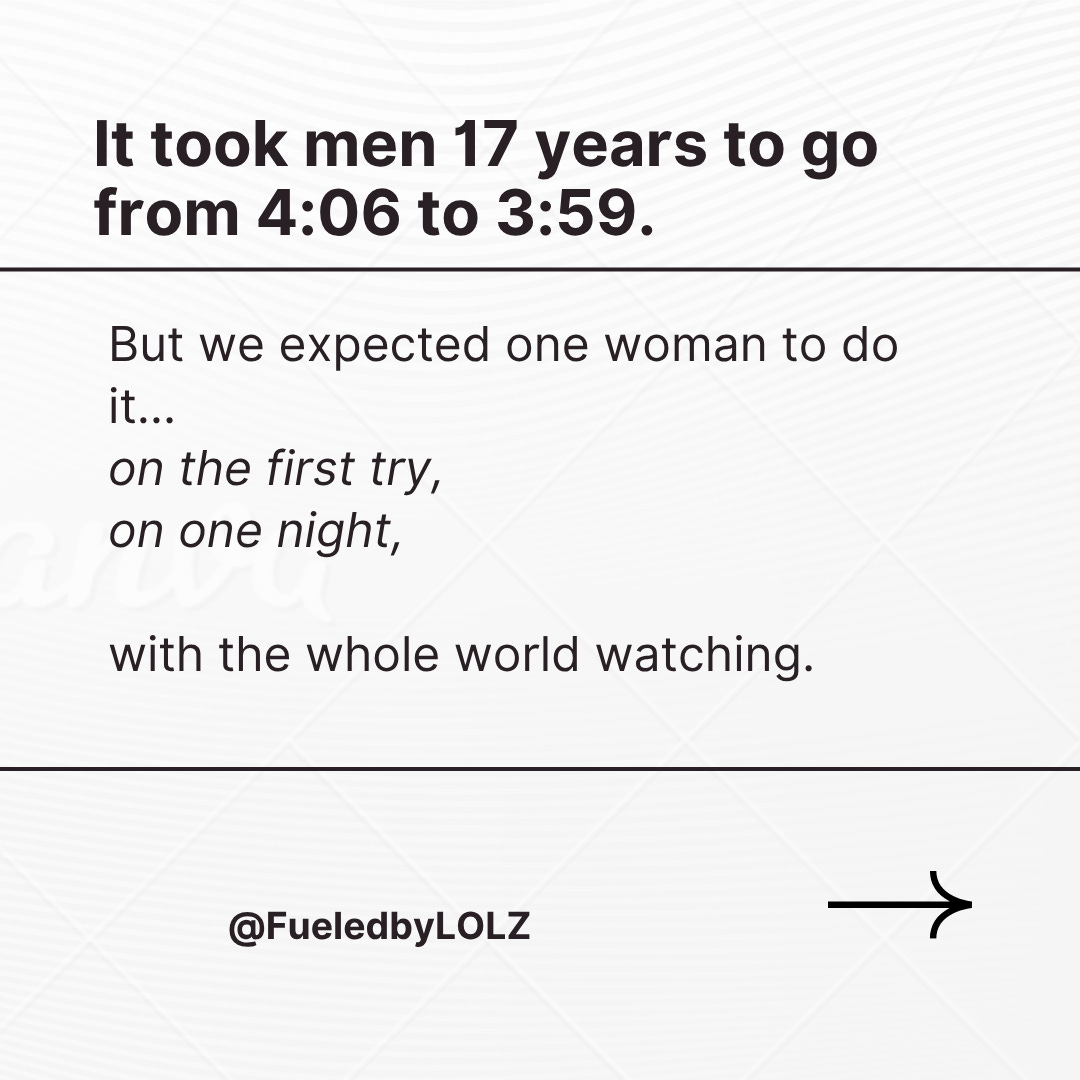Welcome,
Sorry for the delay, I had another post planned for this week BUT I couldn't pass up the opportunity to talk about an event that happened this week: the Breaking4 project, where Faith Kipyegon chased a sub-four-minute mile.
Faith Kipyegon had one lap to go. The clock read 3:01. She needed a 59-second final lap to become the first woman to run a sub-four-minute mile.
She didn’t become the first woman to break 4.
But maybe the real question is: was that ever a fair ask?
On June 26, 2025, Nike held its Breaking4 event in Paris. It was built around one woman, one race, and one goal. The setup was as optimized as it could be: elite pacers, perfect conditions, high-tech gear: and still, the barrier held. Seriously, I have never seen that many high profile middle distance runners in one place?
Kipyegon ran 4:06.42. It won’t go down as a world record because of the pacing format, but it’s the fastest mile a woman has ever run under any conditions and that's cool.
And yet, the reaction from some corners of the internet was familiar: “She missed it.” “It didn’t work.” “Just hype.”
But maybe we need to ask tougher questions...not about Kipyegon’s performance, but about what this event says about how we frame success in women’s sport. It made people hyped to watch women's sports, something we do not see often.
Breaking2 Had Room to Experiment: Did Breaking4?
Nike’s Breaking2 project in 2017 was widely praised, even though it didn’t succeed the first time either. Kipchoge ran 2:00:25, missing the goal but reshaping the conversation around marathoning. He got another attempt, and in 2019, he broke two hours.
But Breaking4 wasn’t structured that way. It wasn’t presented as a stepping stone: it was a one-night-only show.
Why is that?
Why did Breaking2 lead to years of investment, follow-ups, and fanfare, while Breaking4 came together quietly and ended in a single attempt?
It’s hard not to notice the gender gap here. Both efforts were ambitious. Both had elite athletes. But only one got room to grow. (and believe me, I would love to be wrong and see some follow ups).
If this had been a male athlete missing a landmark time by six seconds, would we be talking about “failure”? Or would we be focused on the shoes, the pacing, the conditions: on what we could optimize for next time?
What Went Wrong and Why It Was Inevitable
Let’s talk about the race itself. Kipyegon didn’t get to run the way she usually does. She’s a master of negative splits, of closing hard when it counts. But that wasn’t an option in a race like this. From the gun, she had to hit splits that matched men’s early-lap mile pacing.
A 60-second first lap. That’s faster than any woman ever opens a mile in a record-setting race. There was no easing in. No adjustment. No chance to listen to her body.
At 800 meters, she was at 2:00. Still on pace. Still looking strong.
But by lap three, the fatigue started to show. Her stride lost a bit of fluidity. Her face showed the effort. She hit 1200 meters in about 3:01. That meant she needed a 58-second final lap to make history.
She finished in a gutsy 4:06.42. Her last lap was about 65 seconds.
And here’s the thing: she had no real choice. If she’d opened in 62 or 63, she would have been “off pace” from the beginning. But opening in 60? That set her up for exactly what happened.
This is the part we don’t talk about enough: how much this effort demanded from her body, and how little room she had to respond like a human being instead of a machine.
Nike also confirmed to Runners World that they only used Kipyegon moving time and actually adjusted the time from 4:06.91 down .49 seconds. While I'm all for using every angle to go under 4 minutes, we can't really compare it to previous times that way. Do we need too if the goal isn’t too compare but to go under 4? I don't know.
My Own Opinions:
Eight seconds is actually a lot. Going from 4:07 to 3:59 is a huge leap, especially for someone who has already been training at the professional level for years with access to every resource imaginable. Sure, a running start, drafting, pacers, and the latest tech all help but I don’t think they help that much. But what we don't know: what is/was Kipyegon's fitness? Say she was in 4:10 shape and ran a 4:06, well that's different then if she was in world record 4:07 fitness and ran a 4:06.
Most runners that have run a sub 4 minute mile, have run a sub 1:53 800. The world record for women is 1:53 (which is believed to me a very drugged up one). So realistically we need to have women under 1:53 to have the leg speed and strength to go under 4 minutes.
I’ve heard rumors that this was her idea, and I love that. Because honestly, it was probably an unreachable bar from the start with the technology we currently have. But to get so many runners and nonrunners hyped for a women's sporting event is cool.
Why Are We Only Now Investing in Women’s Records?
Nike brought top-tier support to this race: gear engineered for her body, a team of pacers, and an international stage. That’s worth applauding. But it also raises a question:
Why has it taken this long for a major brand to center a high-profile event around a woman’s performance goal?
Men have had dozens of these “moonshot” attempts in recent decades. Women? Not many. Is it because breaking 4:05 wasn't a "clean number"?
For a long time, women’s distance racing has been treated like the sideshow: receiving second-tier coverage, often wearing shoes and gear that weren’t even designed for them in the first place. Breaking4 felt like a correction. A long-overdue one.
But if this was meant to level the playing field, why wasn’t Kipyegon given more time, more attempts, or even more transparency in the lead-up?
It’s not about criticizing the effort. It’s about asking why it took until now and why we still treat bold attempts from women as make-or-break.
17 years:
There’s a stat I keep thinking about: it took 17 years for the men’s mile world record to go from 4:06.4 (Sydney Wooderson, 1937) to 3:59.4 (Roger Bannister, 1954). No one asked Bannister to do it alone, in one try, under the world’s spotlight.
And yet, here we are, treating Kipyegon’s miss like a finished story.
What if we gave her the same room to breathe, to build, and to come back stronger?
This Got People Talking and That’s a Win
Despite everything, Breaking4 did what few women’s track events ever do: it captured attention.
I’ve never seen this much discussion about the women’s mile.
And that’s the real victory.
Because when the next woman runs 4:05 or when a young girl lines up for her first high school mile...they won’t be starting from scratch. Kipyegon’s effort makes their belief more reasonable. Their barrier smaller.
Even though she didn’t break four, she chipped away at something bigger: visibility.
Final Thoughts
Kipyegon’s attempt was historic, not because of what she ran, but because of what it forced us to confront about pacing, pressure, and how we define success in women’s sport.
Breaking4 didn’t result in a new world record. But it asked us to look at what we celebrate, and why. It reminded us that investment in women’s running matters. And it showed that these moments, failures included, deserve to be seen. If we are being honest, failures are what make these things more relatable.
She ran the fastest mile ever by a woman. And she did it knowing she’d probably miss the mark.
As always, I appreciate you sharing your own thoughts!
What is Keeping Me Entertained?
Atreyu Daily Trainer 2 Shoe Review
2025 Western States 100 Results: Caleb Olson and Abby Hall Win in Historically Fast Finishes









I’m happy she was able to make this attempt and have no doubt in the future a woman will go sub 4. On the other side, as someone who grew up in the heart of Nike USA, I have lots of opinions (none of them positive) on why they do what they do.
I noticed the Atreyu Daily Trainer 2 Shoe Review. According to the email I received from Atreyu (as a former purchaser), "Atreyu will be winding down operations by the end of this year." Just in case...you did not know.